Diving the Cape Peninsula and False Bay/Noah's Ark
Diving the Cape Peninsula and False Bay/Noah's Ark
Noah's Ark redirects here. For the geological formation on Mount Ararat known as Noah's Ark, see Doğubayazıt#Q1267546.
The dive sites Noah's Ark and the Ark Rock Wrecks are rocky reef and historical wreck sites in the Seaforth area on the False Bay side of the Cape Peninsula, near Cape Town in the Western Cape province of South Africa.
Understand

 See also: Diving the Cape Peninsula and False Bay#Understand
See also: Diving the Cape Peninsula and False Bay#Understand
These are minor wrecks of some historical interest and a large exposed rock surrounded by a small high profile reef. There are also a few isolated groups of rocks and structures that were part of a now disused naval degaussing range.
Position
- Noah’s Ark Rock 📍: S34°11.533’ E018°27.232’
- :550 m north of Penguin Point. This is the biggest rock close offshore in the Simon’s Town area, and it is unmistakable as a landmark.
- Ark Rock Barge wreck 📍: S34°11.603’ E018°27.198’
- :120 m from Ark Rock at about 220° magnetic.
- Boiler wreck #1 📍: S34°11.545’ E018°27.173’
- :70 m from Ark Rock at about 280° magnetic.
- :55 m from Ark Rock pinnacle at 265° magnetic
- Boiler wreck #2 📍: S34°11.670' E018°27.196'
- :247 m from Ark Rock at about 218° magnetic.
- :116 m from Ark Rock Barge wreck at about 208° magnetic.
- Boiler wreck #3a 📍: S34°11.632' E18°27.349'
- :240 m from Ark Rock at about 160° magnetic
- Boiler wreck#3b 📍: S34°11.616' E018°27.353'
- :225 m from Ark Rock at about 155° magnetic
- Parana wreck, (1862) 📍: S34°11.477’ E018°27.172’ — (main section)
- :120 m from Ark Rock at about 340° magnetic.
- Parana wreck, (1862) 📍: S34°11.497' E18°27.143' — (small section)
- :120 m from Ark Rock at approximately 320° magnetic
- Double row of concrete pillars 📍: S34°11.618' E18°27.277'
- :150 m from Ark Rock at approximately 180° magnetic
- Single row of concrete pillars 📍: S34°11.649' E18°27.220'
- :197 m from Ark Rock at approximately 211° magnetic
- Eastern wreck 📍: S34°11.530' E018°27.306'
- :85 m from Ark Rock at approximately 115° magnetic
- Heat exchanger? 📍: S34°11.566' E18°27.287'
- :90 m from Ark Rock at approximately 155° magnetic
- Twin barges 📍: S34°11.375' E18°27.125'
- :320 m from Ark Rock at approximately 350°magnetic
These sites are in a Marine Protected Area (2004). A permit is required. These sites are all entirely inside the Boulders Restricted Zone.
Name
The large rock at the site is marked on the SA Navy charts as "Noah's Ark", and is commonly referred to by local divers as "Ark Rock". The wrecks are associated with the rock by being nearby. There is a wreck of a barge just south of the rock, the wreck of a small steam powered vessel to the west and a larger iron or steel vessel, probably the Parana (1862), to the north west. Another small wreck of a steam powered wooden vessel lies to the south of the barge wreck, near a small group of large rocks, and a third boiler lies near a small group of rocks some distance to the east.
Depth
Maximum depth is about 14 m on the north side of the main reef and in the area of the main section of the Parana wreckage. Most of the area south of Ark Rock is sand bottom at 10 to 11 m depth, and most of the wreckage and rocks extend less than 3 m above the bottom.
Visibility
Visibility is not often very good in this area, but can be 5 to 10 m on a good day. It may vary among the listed sites even on the same day.
Topography
Noah’s Ark:
 This is a huge flat topped granite boulder standing on even larger granite outcrop which extends above the sand level. The exposed rock is about 55 m long from east to west and 30 m from north to south. Mostly sheer sided with small overhangs and some deep crevices. The bottom is sand, sloping very gradually from about 10m at the south of the rock to about 8m near Penguin Point. There are a few pinnacles around the main rock, including one to the west, and at least two to the south.
This is a huge flat topped granite boulder standing on even larger granite outcrop which extends above the sand level. The exposed rock is about 55 m long from east to west and 30 m from north to south. Mostly sheer sided with small overhangs and some deep crevices. The bottom is sand, sloping very gradually from about 10m at the south of the rock to about 8m near Penguin Point. There are a few pinnacles around the main rock, including one to the west, and at least two to the south.
The small pinnacle about 12 m to the west of the main rock rises to quite close to the surface and is topped by kelp. This pinnacle is at S34°11.530’ E018°27.207’ and could be a hazard to boats.
There are assorted cables lying around on the sand in this area which are remnants of the old navy degaussing range. Most of these appear to be south of the barge wreck.
Ark Rock Barge:

Boiler wreck 1:
This wreck is the remains of a small unidentified iron or steel vessel which has mostly rusted away, except for the boiler, what might be the engine crankcase and some of the nearby structure. There may also be more of the hull buried in the sand. Everything is heavily encrusted by crinoids, ascidians and other growth, making identification of the components difficult. The wreckage is about 19 m long, 6 m wide and 2 m high (boiler). The centreline of the vessel lies approximately 030° magnetic.
Boiler wreck 2:
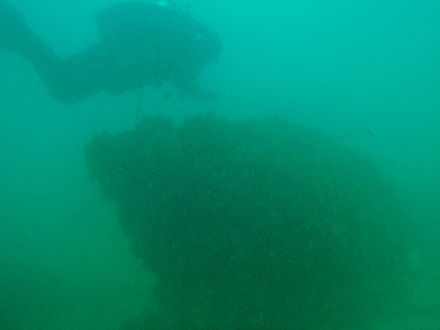
Boiler wreck 3:
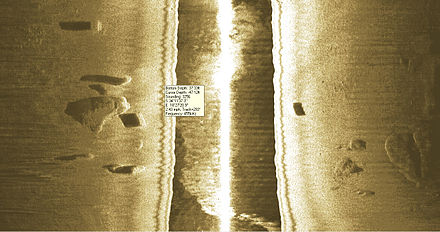
 All that is visible of this wreck are two boilers. They are apparently identical, and about 2 m diameter and about 5 m long, with two fireboxes. Both are fairly intact, and the casing of boiler 3a has no visible openings through the pressure vessel, while an access opening to the pressure vessel is visible on boiler 3b partway along the left side looking from the firebox end. They appear to be Scotch boilers of fairly ordinary design, and both stand upright on the sand. There is probably more wreckage below the sand supporting the boilers, as if unsupported they would probably have bedded in more deeply. The fireboxes are open, and the outside is moderately encrusted with seaweeds and invertebrates. Boiler 3b is about 30 m on bearing 038° magnetic from boiler 3a. Close to the west of boiler 3a is a moderately large granite outcrop, and about 30 m to the north east of boiler 3b is a low flattish reef which drops off steeply to the north east.
All that is visible of this wreck are two boilers. They are apparently identical, and about 2 m diameter and about 5 m long, with two fireboxes. Both are fairly intact, and the casing of boiler 3a has no visible openings through the pressure vessel, while an access opening to the pressure vessel is visible on boiler 3b partway along the left side looking from the firebox end. They appear to be Scotch boilers of fairly ordinary design, and both stand upright on the sand. There is probably more wreckage below the sand supporting the boilers, as if unsupported they would probably have bedded in more deeply. The fireboxes are open, and the outside is moderately encrusted with seaweeds and invertebrates. Boiler 3b is about 30 m on bearing 038° magnetic from boiler 3a. Close to the west of boiler 3a is a moderately large granite outcrop, and about 30 m to the north east of boiler 3b is a low flattish reef which drops off steeply to the north east.
Eastern Wreck:
 To the east of Ark Rock is a small iron or steel wreck. The hull is almost complete in outline, with a few gaps. The wreck lies upright on the slightly sloping sand bottom at about 14m depth, with the bow to the north west. The hull is about 4 m wide, and probably about 10 m long. The remains of the topsides extend a bit over a metre from the sand in most places. No trace of a deck remains, and no trace of an engine can be seen.
To the east of Ark Rock is a small iron or steel wreck. The hull is almost complete in outline, with a few gaps. The wreck lies upright on the slightly sloping sand bottom at about 14m depth, with the bow to the north west. The hull is about 4 m wide, and probably about 10 m long. The remains of the topsides extend a bit over a metre from the sand in most places. No trace of a deck remains, and no trace of an engine can be seen.
Heat exchanger?
A heavily overgrown piece of wreckage about 2 m long and 1.5 m diameter lies on a fairly extensive and moderately flat rubble bottom at about 9 m depth. A hole in one end (probably the north end) allows a view of a perforated plate with possible tubes on the other side. This has the look of some form of heat exchanger, but probably not a boiler.
"Parana" 1862
The wreckage of an iron or steel ship which may be the Parana. The wreckage is mostly buried under the sand, with a long strip of hull plating and frames projecting about 0.5 to 1 m above the sand. The frame spacing is about 0.5 m, and a stringer can also be seen. There are two vertical cylindrical objects about 1.8 m diameter and a bit over a metre visible height with small rectangular horizontal openings on the sides, and some door frames and cast iron porthole frames mostly buried in the sand. The main debris field is about 40 m long and about 2 to 5 m wide at about 120° magnetic. Two other minor debris fields which may be parts of this wreck are known. One is to the north at an unknown position, and the other is to the south at S34°11.497’ E018°27.143’
Concrete pillar arrays
There are two groups of concrete pillars aligned in rows on the sand bottom. There is a double row, originally of 14 pillars in each row, spaced about 2 m apart and aligned magnetic north/south, with a gap of about 10 m between the rows. This group is centred at S34°11.618' E18°27.277'. The west row now has only 12 pillars, as the southern two have fallen over. They are about 200 mm diameter and about 2 m high. The east row still has all 14 and they are about 600 mm diameter and 3 m high.
There is also a single row of pillars, almost identical in size and arrangement to the larger row of the first group, to the west, and centred at S34°11.649' E18°27.220' and aligned magnetic east/west. The extended axis of this group intersects the south end of the first group, at a distance of about 88 m These pillars are about 2.5 m high.
Twin Barges
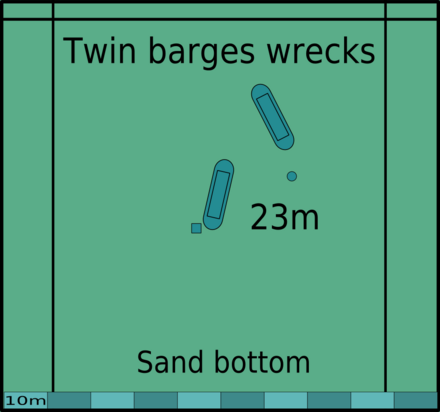 Two small steel barges, each about 17 m long and 4 m wide, in reasonably intact condition about 320 m north of Ark Rock, lying on sand at 23 m.
Two small steel barges, each about 17 m long and 4 m wide, in reasonably intact condition about 320 m north of Ark Rock, lying on sand at 23 m.
Geology: Granite of the late Pre-Cambrian Peninsula pluton, surrounded by fine white quartz sand.
Conditions
Can be dived any time the swell is low and the wind is not too strong. Mostly this will be autumn or winter, as a strong south-easter will push up an unpleasant chop. For a shore dive, choose a day when there is not too much wind, as this may set up a surface current.
Facilities
Parking for shore dives at bottom of Bellevue road at the penguin sanctuary.
Get in
See also: Diving the Cape Peninsula and False Bay#Boat dives
Generally considered a boat dive from Simon's Town jetty or Miller's Point slipway, though all can be dived from shore entry at Penguin Point. There is a swim of about 30 minutes each way, which could be tiring in a chop. The Ark Rock is clearly visible and cannot be missed.
This site can also be dived as a coastal underwater orienteering swim. A route from the Pumphouse gulley at Penguin Point via Compass Reef, Photographer's Reef and North Photographer's Reef to Ark Rock, and returning via the Ark Rock Barge wreck, and Boiler wreck 2 to Boulders Beach has been planned and tested. The total point to point distance is about 2 km.
<maplink text="" latitude="-34.0" longitude="18.6" zoom="9" group="TMNPMPA" class="no-icon"> {"type": "Feature","geometry": {"coordinates": [[18.470833,-34.109833],[18.556883,-34.109833], [18.556883,-34.407400],[18.250000,-34.407400], [18.250000,-33.901250],[18.400617,-33.901250]], "type":"LineString"}, "properties":{ "title": "Table Mountain National Park Marine Protected Area", "description": "Seaward boundary", "stroke":"#ffff00", "stroke-width":3 }} </maplink> <maplink text="" latitude="-34.0" longitude="18.6" zoom="9" group="KRZ" class="no-icon"> {"type": "Feature","geometry": {"coordinates": [[18.364117,-33.979283],[18.296617,-33.979283], [18.296617,-34.061000],[18.337533,-34.061000]], "type":"LineString"}, "properties":{ "title": "Karbonkelberg Restricted Area", "description": "Seaward boundary", "stroke":"#ff9900", "stroke-width":2 }} </maplink> <maplink text="" latitude="-34.0" longitude="18.6" zoom="9" group="COGHRZ" class="no-icon"> {"type": "Feature","geometry": {"coordinates": [[18.369900,-34.209517],[18.369900,-34.294833], [18.391667,-34.306650],[18.404300,-34.306650]], "type":"LineString"}, "properties":{ "title": "Cape of Good Hope Restricted Area", "description": "Seaward boundary", "stroke":"#ff9900", "stroke-width":2 }} </maplink> <maplink text="" latitude="-34.0" longitude="18.6" zoom="9" group="PRZ" class="no-icon"> {"type": "Feature","geometry": {"coordinates": [[18.474400,-34.275817],[18.483333,-34.275817], [18.483333,-34.295733],[18.467000,-34.295733]], "type":"LineString"}, "properties":{ "title": "Paulsberg Restricted Area", "description": "Seaward boundary", "stroke":"#ff9900", "stroke-width":2 }} </maplink> <maplink text="" latitude="-34.0" longitude="18.6" zoom="9" group="CRRZ" class="no-icon"> {"type": "Feature","geometry": {"coordinates": [[18.475133,-34.235000],[18.488333,-34.235000], [18.488333,-34.258000],[18.472400,-34.258000]], "type":"LineString"}, "properties":{ "title": "Castle Rock Restricted Area", "description": "Seaward boundary", "stroke":"#ff9900", "stroke-width":2 }} </maplink> <maplink text="" latitude="-34.0" longitude="18.6" zoom="9" group="BRZ" class="no-icon"> {"type": "Feature","geometry": {"coordinates": [[18.446033,-34.192783],[18.453267,-34.176350], [18.463017,-34.176350],[18.463017,-34.211750]], "type":"LineString"}, "properties":{ "title": "Boulders Restricted Area", "description": "Seaward boundary", "stroke":"#ff9900", "stroke-width":2 }} </maplink> <maplink text="" latitude="-34.0" longitude="18.6" zoom="9" group="SJRZ" class="no-icon"> {"type": "Feature","geometry": {"coordinates": [18.459467,-34.118717],[18.459467,-34.126117],[18.450833,-34.126117](18.459467,-34.118717],[18.459467,-34.126117],[18.450833,-34.126117), "type":"LineString"}, "properties":{ "title": "St James Restricted Area", "description": "Seaward boundary", "stroke":"#ff9900", "stroke-width":2 }} </maplink>See

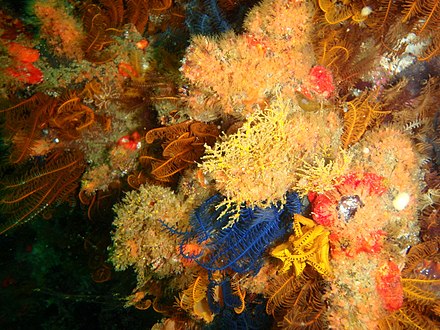

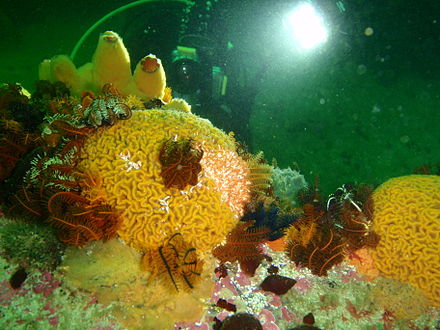


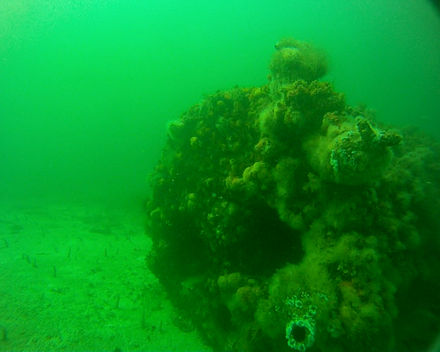
Marine life
See also: Diving the Cape Peninsula and False Bay#The marine ecology
Noah’s Ark: There is a band of Black mussels and barnacles around the rock to about 1 m below surface, then Red-bait on deeper surfaces. The vertical surfaces and overhangs are heavily encrusted with organisms typical of the area, and include sponges, crinoids, ascidians, sea cucumbers, hydroids and sea fans.
Features
See section on topography of each wreck.
Photography
(photographic equipment suggestions)
Routes
-
Boat dive: Put down a shot line over the Parana wreck. Descend and look at the wreckage, then swim a compass course of 255° magnetic for 58 m to a large piece of unidentified wreckage that projects about 2 m from the sand at S34°11,497’ E018°11.497’. This debris field is about 12 m long at 140° magnetic and may be part of the same ship. From this point swim 100 m at 177° magnetic to the Boiler Wreck, then either to Noah’s Ark 70 m at 098° magnetic or to the Ark Rock Barge 115 m at 184° magnetic. If you wish to continue to Noah’s Ark from the barge, the course is 040° magnetic for about 120 m. This route has not been tested. Alternatively, swim 116 m on bearing 208° to the Boiler wreck 2
-
Orienteering boat dive: This is a variation on the second long coastal orienteering dive listed below, but is shorter and skips the long swims to and from the shore. The total distance is about 1 km, and maximum depth about 15 m. (This route has not been tested).
- From the west end of the wreckage of the "Parana", swim 46 m on bearing 233° magnetic to the south west section of the wreck of the "Parana".
- From the south end of the small section of the wreck of the "Parana", swim 87 m on bearing 180° magnetic to Boiler wreck #1.
- From the south west end of Boiler wreck #1, swim 115 m on bearing 182° magnetic to the Barge wreck.
- From the south west corner of the Barge wreck, swim 73 m on bearing 182° magnetic to the Single row of pillars.
- From the west end of the pillars, swim 40 m on bearing 236° magnetic to Boiler wreck #2.
- From the boiler of Boiler wreck#2 swim 44 m on bearing 062° magnetic to the single line of 14 concrete pillars, and swim along the pillars to the east end.
- From the east end of the single line of pillars, swim 89 m on bearing 080° magnetic to the double line of pillars, and swim to the east row (the bigger pillars).
- From the south end of the east row, swim 83 m on bearing 125° magnetic to the reef at Boiler wreck #3. The boiler #3a is 20 m further east on the east side of the biggest rock of the group.
- From the north side of the boiler #3a, swim 30 m on bearing 038° magnetic to the Boiler #3b.
- From the north end of the boiler #3b, swim 139 m on bearing 337° magnetic to the Heat exchanger. This landmark is on a bottom of rubble, is overgrown with the same sort of organisms that cover the bottom, and is not very big. If you miss it and continue on the same bearing, you should get to Ark Rock after another 60 or 70 m.
- From the heat exchanger, swim 70 m on bearing 050° to the Eastern wreck.
- From the northwestern end of the Eastern wreck, swim about 60 m on bearing 290° magnetic to Ark Rock east side. You can swim round Ark Rock either way to the west side. The southern route is a bit more scenic, as you will pass the Twin Peaks pinnacles.
- From the overhang at the west side of Ark Rock at 6 m depth, swim 15 m on bearing 315° magnetic to the Western pinnacle.
- From the north western side of the Western pinnacle, swim 104 m on bearing 355° magnetic to the main section of the wreck of the "Parana".
-
Shore dive: Surface swim from entry at the low rock at the north of Penguin Point to the south side of Noah’s Ark (about 550 m). Descend and dive round the rock until back at start. Swim a compass course 220° magnetic along the sand bottom about 120 m to the Barge wreck. Do a quick tour of wreck and continue toward Penguin Point, crossing over some electrical cables on the way. It may be better to exit at one of the other exit points if conditions require.
-
Long coastal underwater orienteering dive #1 This area has been dived as part of a long orienteering route taking in Compass Reef, Photographer's Reef and North Photographer's Reef. The swim will take somewhat over an hour excluding time spent looking at the scenery and swimming around the landmarks, and depending on your cruising speed. The point to point distance is about 2 km.
- Start at the "Pumphouse" gully just south of Belleview road. Follow the route to Compass Reef, Photographer's Reef and North Photographer's Reef given in the Photographer's Reef article, then swim 425 m on bearing 354° magnetic to get to Ark Rock. Along the way you may see the remains of instrument bases, with concrete pillars in two rows about 267 m from North Photographer's Reef. If you do you are a bit to the west of your desired course and should correct by about 3° to the east.
- From Ark Rock swim 130 m on bearing 227° magnetic to the Barge wreck.
- From the Barge swim 116 m on bearing 208° to the Boiler wreck 2
- From Boiler wreck 2, swim about 400 m on bearing 220° magnetic to the beach at Boulders penguin sanctuary. You will have to surface when you come to the inshore reefs, as the water is very shallow over them, and you need to cross them to get to the small and very protected sandy beach. Use the steps to the left facing the beach to leave the beach. There is a no-entry sign at the steps to the right. The path leads back to the parking area at the bottom of Bellevue road.
- Long coastal underwater orienteering dive #2 Another long compass navigation exercise is to dive all the Ark Rock wrecks and several of the other reefs and features on a single shore dive. This swim is about 1.8 km long. Large cylinders will be necessary. (this route has not been tested yet)
-
Start at Boulders Beach. Enter the water and surface swim out to the north side of the high rock in front of the exit steps.
-
Swim 250 m on bearing 038(040?)° magnetic to the low group of small rocks.
-
From the north side of the low group of small rocks, swim 100 m on bearing 035° magnetic to the Boiler wreck #2 with small group of high rocks to the east. The boiler is just to the north of a long low outcrop.
-
From the boiler of Boiler wreck#2 swim 44 m on bearing 062° magnetic to the single line of 14 concrete pillars, and swim along the pillars to the east end.
-
From the east end of the single line of pillars, swim 89 m on bearing 080° magnetic to the double line of pillars, and swim to the east row (the bigger pillars).
-
From the south end of the east row, swim 83 m on bearing 125° magnetic to the reef at Boiler wreck #3. The boiler #3a is 20 m further east on the east side of the biggest rock of the group.
-
From the north side of the boiler #3a, swim 30 m on bearing 038° magnetic to the Boiler #3b.
-
From the north end of the boiler #3b, swim 139 m on bearing 337° magnetic to the Heat exchanger. This landmark is on a bottom of rubble, is overgrown with the same sort of organisms that cover the bottom, and is not very big. If you miss it and continue on the same bearing, you should get to Ark Rock after another 60 or 70 m.
-
From the heat exchanger, swim 70 m on bearing 050° to the Eastern wreck.
-
From the northwestern end of the Eastern wreck, swim about 60 m on bearing 290° magnetic to Ark Rock east side. You can swim round Ark Rock either way to the west side. The southern route is a bit more scenic, as you will pass the Twin Peaks pinnacles.
-
From the overhang at the west side of Ark Rock at 6 m depth, swim 15 m on bearing 315° magnetic to the Western pinnacle.
-
From the north western side of the Western pinnacle, swim 104 m on bearing 355° magnetic to the main section of the wreck of the "Parana".
-
From the west end of the wreckage of the "Parana", swim 46 m on bearing 233° magnetic to the south west section of the wreck of the "Parana".
-
From the south end of the small section of the wreck of the "Parana", swim 87 m on bearing 180° magnetic to Boiler wreck #1.
-
From the south west end of Boiler wreck #1, swim 115 m on bearing 182° magnetic to the Barge wreck.
-
From the south west corner of the Barge wreck, swim 73 m on bearing 182° magnetic to the Single row of pillars.
-
From the west end of the pillars, swim 40 m on bearing 236° magnetic to Boiler wreck #2.
-
From Boiler wreck 2, swim about 400 m on bearing 220° magnetic to the Beach at Boulders penguin sanctuary. You will have to surface when you come to the inshore reefs, as the water is very shallow over them, and you need to cross them to get to the small and very protected sandy beach. Use the steps to the left facing the beach to leave the beach. There is a no-entry sign at the steps to the right. The path leads back to the parking area at the bottom of Bellevue road.
Stay safe
See also: Diving the Cape Peninsula and False Bay#Stay safe
Hazards
No site-specific hazards have been reported
Skills
No special skills required. Reasonable fitness is necessary to do this as a shore dive, due to the long swim.
Equipment
See also: Diving the Cape Peninsula and False Bay#Equipment
A compass is necessary if you wish to return to shore or navigate between the wrecks under water, and a SMB is desirable to warn boats of your presence during the long swim. A light will help you see into crevices, but is not essential.
Nearby
- Phoenix shoal 📍
- Ammunition Barges 📍
- Ammo Reef 📍
- Anchor Reef 📍
- Maidstone Rock 📍
- Photographer’s Reef 📍
- Penguin Point 📍
- Dangerous Doug Reef 📍
Back to the Alphabetical list of sites, or list of dive sites in the Seaforth to Froggy Pond area
Other regional dive sites:
